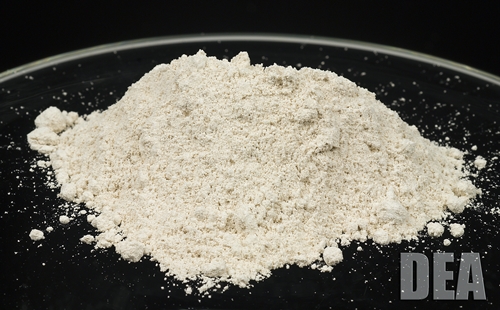
Heroin powder (Drug Enforcement Administration)
14 November 2016. An experimental long-acting drug was shown at least as effective, and in some cases superior, to the current standard of care for opioid use disorder. The first results of a late-stage clinical trial testing the drug code-named CAM2038 were released today by its developers Braeburn Pharmaceuticals in Princeton, New Jersey, and Camurus AB in Lund, Sweden.
Opioids work by reducing the intensity of pain signals to the brain, particularly regions of the brain controlling emotion, which reduces effects of the pain stimulus. Examples of leading opioid prescription pain medications are hydrocodone, oxycodon, morphine, and codeine. Heroin is also considered an opioid.
The U.S. Department of Health and Human Services says the country is in the midst of a “prescription opioid overdose epidemic.” In 2014, according to Centers for Disease Control and Prevention, more than 28,000 people died from opioid overdose, and at least half of those deaths involved a prescription opioid, with even more becoming addicted to prescription and illegal opioids. Heroin-related deaths also increased sharply, more than tripling since 2010, leading to more than 10,500 deaths in 2014.
CAM2038 is a formulation of the drug buprenorphine that acts on the same receptors in the brain as heroin and morphine, providing enough satisfaction of those receptors without producing the intense “high” or serious adverse effects of abused drugs. Camurus adapted its injection technology that the company calls FluidCrystal for CAM2038 that combines buprenorphine with a liquid lipid solution to form a gel that that can be injected, yet breaks down slowly in the body to allow for release over extended periods of time.
CAM2038 is designed for delivery via injections under the skin by clinicians, as part of anti-addiction therapy. The formulation of CAM2038 can be adjusted for the length of time buprenorphine needs to be released, in this case either over the course of one week or one month. In 2014, Braeburn Pharmaceuticals licensed from Camurus the North American rights to CAM2038 and the companies took part in three early- and intermediate-stage trials of the drug on 176 healthy volunteers and patients.
The clinical trial seeks to test the effectiveness of CAM2038 injections given weekly or monthly, compared to buprenorphine and naloxone taken daily by absorbing tablets under the tongue, considered the current standard of care. Some 428 individuals age 18 and over, suffering from and in treatment for opioid use disorder, took part in the trial. Participants were randomly assigned to receive either:
(1) Injections of CAM2038 once a week for 12 weeks, then once a month, in a higher dose, for another 12 weeks, plus placebo daily tablets, or
(2) Daily buprenorphine/naloxone tablets for 24 weeks, plus placebo injections first at once week, then once a month.
The study aims primarily to find if CAM2038 injections are at least equivalent to the daily buprenorphine/naloxone tablets in reducing opioid use, as determined by urine samples. The trial also measured overall percentages of samples without signs of opioids, as well as monitored participants’ vital signs and other general health measures as indicators of adverse effects.
The results show equal rates of response for both weekly or monthly injections and daily tablets, as determined by at least one-third of urine samples without opioids in the first 12 weeks, and two-thirds of samples opioid-free in the second 12 weeks. And while not the main objective of the study, participants receiving CAM2038 injections reported lower rates of urine samples with opioids in weeks 5 to 24, compared to individuals receiving the tablets.
The companies say safety profiles were similar for both treatments, with 3 percent of CAM2038 injection recipients and 6 percent of tablet recipients reporting adverse effects. Injection-site reactions were reported in 19 and 22 percent of the injection and tablet recipients respectively, none severe. No overdoses were reported among injection recipients, while 4 of the participants receiving the tablets had overdoses, 3 from heroin, but none were fatal.
Michelle Lofwall, Professor of behavioral science and psychiatry at University of Kentucky and the study’s lead investigator, says in a joint company statement, “If approved, the CAM2038 weekly and monthly injectable buprenorphine medications can improve how we treat opioid addiction and decrease the stigma associated with the medication that is in large part due to concerns about non-adherence and diversion.”
In November 2015, CAM2038 received Fast Track designation from the U.S. Food and Drug Administration. In May 2016, FDA approved a six-month buprenorphine implant for maintenance treatment of opioid dependence, made by Braeburn.
Read more:
- Teva Licenses Pain Relief Antibody for $1.25 Billion
- Non-Addictive Pain Medication Shown Working in Animals
- Safer Pain-Killing Drug Candidate Discovered
- Trial Shows Pain Drug Effective as Heroin Treatment
- Electronic Patch Offers Pain Relief, Cuts Medication Use
* * *

 RSS - Posts
RSS - Posts
You must be logged in to post a comment.